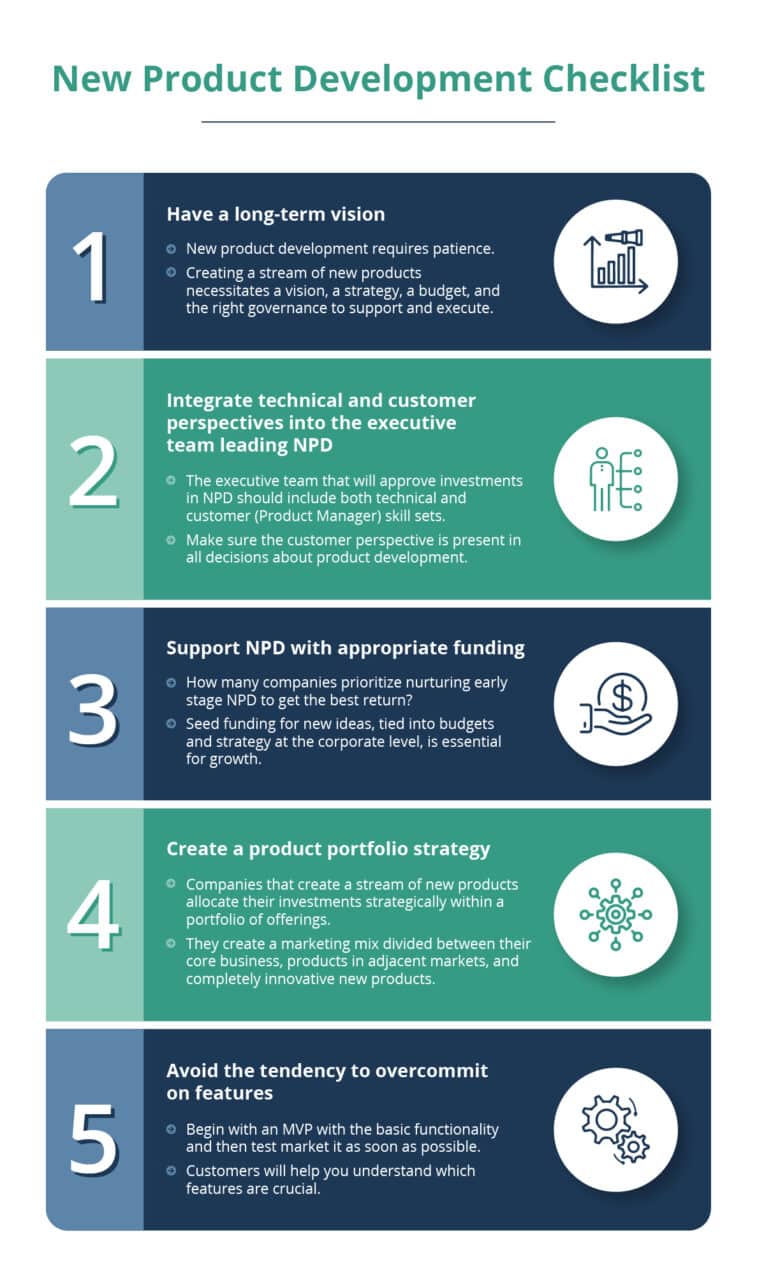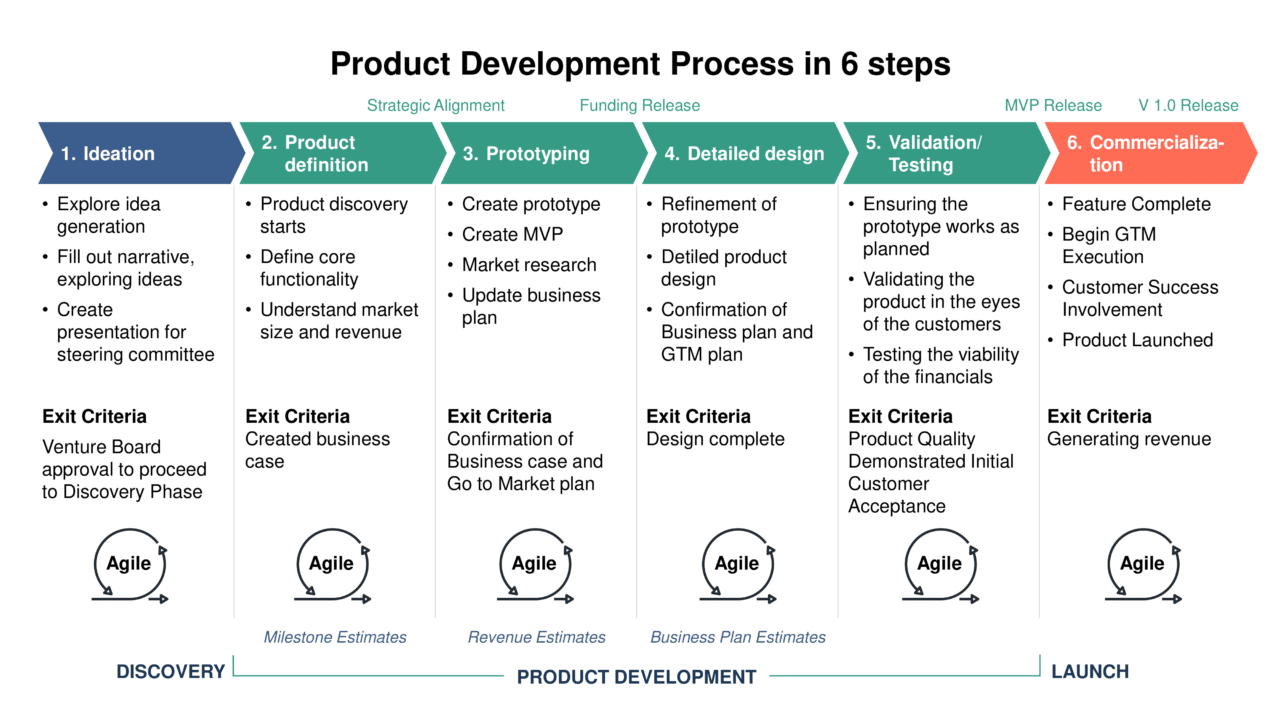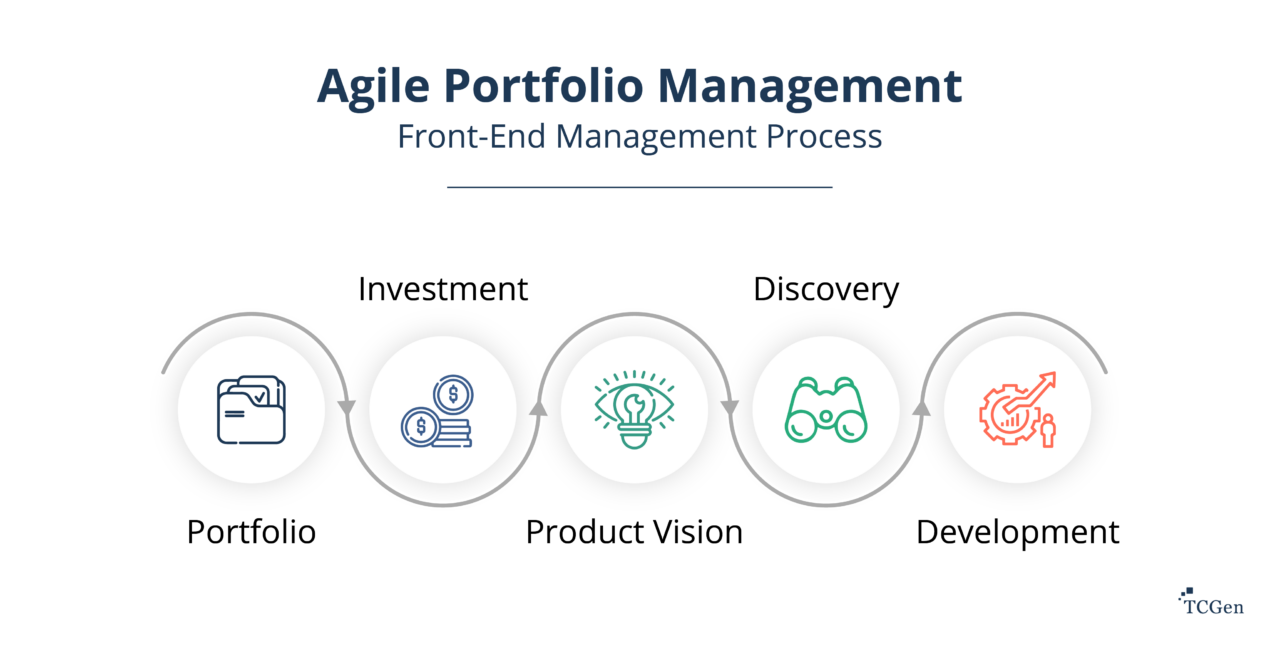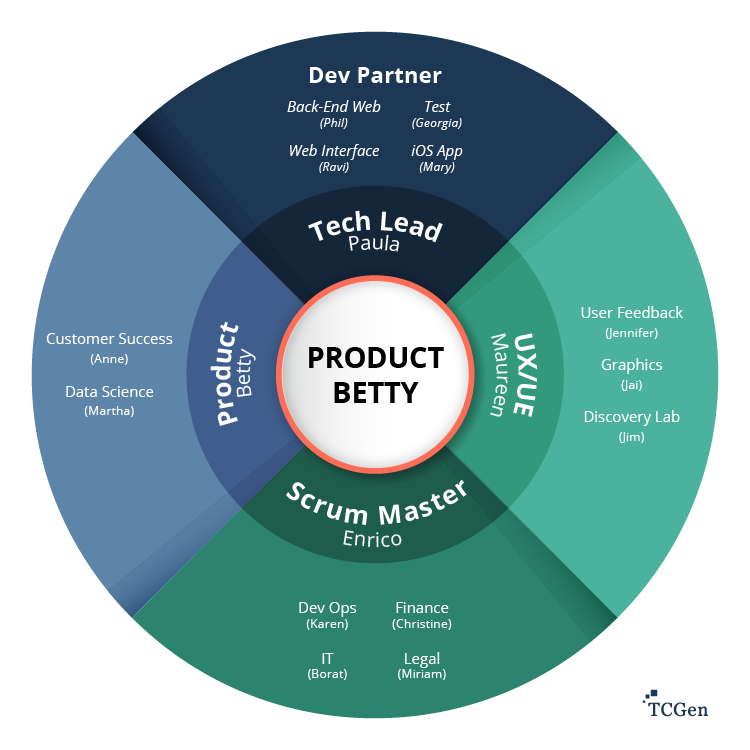What is new product development (NPD)?
New product development is the ideation, design, production, pricing, and launching of new products to your target customers to provide a solution that addresses an important need.
For new businesses (eBay, Shopify, Etsy, WooCommerce, Magento – or anyone with an App idea), you should have…
- A great idea that is different from existing solutions
- An understanding of the market and what your customers want
- A plan to scale up your idea into a product that can generate real revenues
- The budget to invest in design resources or a partner to do product development
For established, successful companies, the best new product development organizations have…
- The right governance to select novel product concepts
- Sufficient funding to allow these new opportunities to grow
- A process for vetting and prioritizing them; for selecting the best ideas; and for the successful product launch of new-to-the-world concepts.
- A comprehensive view of a product’s stages as part of a product development life cycle.
NPD, in its full form in marketing, is a commitment to innovation. New products are created through innovation in two ways, and there are successful models for each. There is no single way, but these two models explain the way most innovative companies manage their new product development process.
One common misunderstanding is that technology companies often ignore market research, market testing, and assessing customer needs. This is not true. Successful business models always include some budget and staff for these research activities.
Through our consulting business, we have had an opportunity to see critical success factors in New Product Development. We have codified this in a checklist that you can use to audit and improve your process.

The starting point begins with product development strategy. The strategy framework incorporates the firm’s risk tolerance and appetite for growth from new products. The alternate approach is a product marketing-led strategy to optimize profit and sales from in-market products. The next phase is either research for technology-driven products or concept development for market-driven products. After these stages, the project moves into development. Here we discuss the phases of new product development with the help of examples.
Stages of New Product Development
A typical new product development process has six steps with five gates.
Step 1: Idea Generation (Ideation)
Step 2: Product Definition
Step 3: Prototyping
Step 4: Detailed Design
Step 5: Validation/Testing
Step 6: Commercialization

Who is involved in new product development?
New product development is a cross-functional activity. It involves people from many different groups across your business. Cross-functional teams come together in the idea generation stages to develop the initial product concept.
In many industries, these functions might include design engineering or coding, concept testing; product management; sales, finance, and others. There is also a team leader or scrum master. A cross-functional team stays together throughout the new product development cycle. If your organization develops hardware products or works with a manufacturing partner, you may want to spell out the functional involvement in a New Product Introduction (NPI) process.
In addition, a Senior Management team oversees and approves the project as it develops. They have a responsibility for the investments they make in new product development.
The best product development processes have roles and responsibilities that are clearly defined – for the development team, including product managers, and for the Senior Management team – so as to limit meddling by management. Additionally, a product development consultant can be involved.
NPD (New Product Development) examples
Apple
Apple protects new product concepts by separating the product design team from all other parts of the business. The team is shielded from bureaucracy and the usual hierarchy. They might even be discouraged from communicating with other employees.
The team then follows an articulated Apple New Product Process (ANPP) where the team answers in detail the what, who, why, how, and when questions related to the product. Apple’s methodology depends on iteration around its product roadmap. They will continue to test and revise new products even after they have moved to the manufacturing phase.
Design teams report to the executive team directly. On Mondays, the executive team meets to review the products currently in development. When products move from design into production, an engineering program manager and a global supply manager take over the manufacturing cycle.
Each product has an elaborate product launch plan which is held in strict secrecy. This action plan is called “Rules of the Road” and contains everything required for the commercialization and launch of the final product.
The tech giant uses a Design Sprint approach for new products. Each brief sprint conducts an experiment that the team then hands over to the next sprint to move the product to the finish line.
This approach uses five development stages led by a Sprint Master.
- Understand: the first phase is to comprehend the challenge. Teams brainstorm and conduct short, fast meetings to generate insights that define the end-user’s problem. Key acronym: HMW (How Might We).
- Sketch: Sketching is one approach to ideation. Each team member is then left alone to sketch their own solution to the user’s problem, taking into account stakeholder input. The team then meets, and members share their ideas. The team votes on the ideas and eliminates some.
- Decide: The team then attempts to reach a decision regarding which idea is the best solution for end-users. If the team does not come to an agreement, then they might use a Decision Matrix to rate solutions against a set of requirements. They also rate the risk vs. value proposition of the proposed solutions.
- Prototype: Proposed solutions are built out in order to get real-time feedback from testing. This stage, which involves concept testing, is about getting rapid feedback to see what will and won’t constitute a viable product.
- Validate: The team then shows the prototype to real users, its target audience. The team may observe customers using the solution. The team then reviews and absorbs their findings together. The team leaves a trail of learnings for the next sprint, which will further the new product development project.
Kellogg
Nigel Hughes, Kellogg’s senior vice president of global research and development, summarized his company’s new product development approach in early 2021:
“We’ve revamped our whole end-to-end innovation capability to focus on our core food design skills: investing in culinary to get closer to the real food experience; sensory, to equitably learn with the consumer; a design studio and rapid process lab to speed up our prototyping; a scaled-up pilot, which is now certified to make salable food; and finally, our Menuvation Center at The Hatchery in Chicago to showcase our foods with partners and customers.
“These changes give us a real leg up on the competition because they allow us to hit trends, influence new trends, and grow our business. They’ve transformed our ability to innovate.”
Characteristics of a successful NPD organization
- Successful NPD starts with new product concepts in response to customers’ needs
- The best new product concepts are aligned with a corporate product development strategy
- The ideas are nurtured by a flexible, lightweight process
- Agile cross-functional teams perform the work in keeping with an articulated new product development process
- The result is a new product that delights customers while growing the business
Product Strategy starts at front end of the NPD process
One of the consistent challenges of NPD is managing the earliest stages, when concepts are in an embryonic state. Consistent steps for managing the front end of development help to maintain focus on the tasks necessary to launch the projects that will best realize your strategy. Here you think like an entrepreneur who avoids falling in love with the finished products but rather frames all concepts as MVP (Minimum Viable Products).
We urge companies to think of their early-stage product concepts, however vague or aspirational, as an asset, as a product portfolio managed like a portfolio of capital investments. The process of concept development and testing, getting customer feedback on real-world prototypes, can’t be underestimated.
The assets in the product portfolio represent an as-yet unrealized potential. This is a simple but important shift in mental models. There should be many sources of new product ideas, including those that come through social media. Often these channels highlight rapid adoption – but you must do your homework before falling in love with a short-lived fad.
Many ideas in the portfolio of early-stage concepts are worth little or nothing to your company. For example, they might not address your target market and often come out of causal brainstorming that really glorifies similar products without any differentiation. Others might be the next iPhone or Amazon, ready to disrupt markets, open new categories, enter new markets, and earn enormous revenues. How can your company manage these vague concepts to leverage the best, weed out the rest, and develop the winners into new opportunities in a competitive marketplace, thereby gaining a competitive advantage and staying ahead of competitors?
Many companies maintain that the front end cannot have specific milestones and deliverables. We disagree. Just as projects within the product development pipeline have gates, reviews, and timelines, you can manage the front end of development in a similar fashion. What you need is a solid marketing plan with a compelling narrative that describes the value proposition for the target customer.
An orderly front-end management process uses rational decision-making to select the right projects or product ideas to load into the pipeline. Though it can start with idea generation, it can’t be completed until you have verified the product-market fit with focus groups or through customer interviews. This starts with customer requirements and ends with content development and testing.
A front end process also has milestones and budgets that are the measure of progress. Approved budgets unlock new projects. Product discovery is then the process of translating strategy into action.

Steps and Deliverables
To bring order to the front end of development, first create two decision points that help to:
- Manage an orderly starting point for projects
- Staff projects properly with the right resources
- Ensure that the projects will address any factors that might impede fast and predictable development
- Show meaningful commercial potential for your new product ideas
Define the placement of these decision points. Select two points in time to review projects at a high level.
- First Review (move from Pre-Discovery to Product Discovery): ensures that the product idea is worthy of forming a cross-functional team and outlines the steps to test the hypothesis – this phase is complete when the effort transitions from one individual to a small team, typically 10-15% of the way down the path
- Second Review (move from Product Discovery into Development): ensures that the team demonstrates feasibility, defines the broad parameters of the product offering, and addresses risk. This phase should ensure that the team is ready to enter development, that they grasp the major risks, and that the team is within a quarter or two of entering the formal development pipeline.
A front-end product innovation system also includes a related set of deliverables that proposed programs (products, technologies, and investigations) must pass through in order to ensure that the team has considered both the risks and the proposed program’s alignment with strategy.
These deliverables in the Product Discovery phase may include:
- First Review/Approval: The leadership team reviews the proposed opportunity for strategic fit and approves or denies requests for further investment
- Market Assessment: Validates and documents the under-served market need
- Commercial Feasibility Assessment: Describes the target segments and potential customers and documents the commercial potential
- Technology Assessment: Summarizes proposed technologies, missing elements, critical partners, and known technical risks
- Second Review/Approval: The leadership team reviews the request to enter the product process and approves or denies requests for further investment
Other documents might include:
- Business Case/Business Analysis: Includes relevant estimates and metrics for market share, conversion rates, click-through rates, activation rates, consumables trail, cannibalization, ASPs, NPV, IRR, payback period, gross profit, and operating profit. Also, it may include an explanation of the business risks, along with a SWOT analysis.
- Business models: New products may require new ways to think about business models, such as a shift towards SAAS and recurring annual revenue models
- Business Assessment: Verifies commercial and, where applicable, regulatory readiness and might include prototyping to get better feedback
- Early Phase Report: Provides evaluation of technological feasibility, manufacturability, and costs
- Updated Portfolio Roadmaps: Prioritizes newly approved projects
A Venture Capital Model
The way for more mature companies to create a stream of product concepts is to rethink NPD in terms of a venture capital model. Think of the product teams within an organization as so many start-ups, funded and monitored by venture capital. Within the company, new product development projects compete for unallocated funding, where a small number of executives continually sift through bottom-up ideas and fund the most promising.
Within this model, a company needs a governance structure that constantly selects teams pursuing new ideas and creates a protected space for innovation. Next, it needs a process for vetting new ideas to reveal their potential. Finally, it needs an Agile funding model with a substantial budget earmarked for innovation.

- Governance: Get the right leaders to the table and give them oversight of fragile innovations. They allocate capital from the pool of venture funds as and when needed. We call this team the venture board. They may or may not oversee all of product development.
- Process: Establish a process for receiving and selecting ideas; identify how to transfer ideas into development using clear entrance and exit criteria.
- Finance: Create a specific investment for the strategic innovation portfolio and approve it in the budget year. Make it large enough to start at least three projects (in round figures, about $10M per thousand employees).
The venture board manages the innovation portfolio. It greenlights programs or segments for investment, reviewing the allocation of resources and budgeting. The venture board performs a high-level review of the budget on a regular basis, twice per year in some companies.
It is also this board’s responsibility as executives to foster any cultural changes needed to support the portfolio of innovative ideas. They own the product portfolio and are tasked with maintaining this perspective.
No tradeoff between innovative new products and speed
Some companies settle for a rapid-follower approach to product development (a “me too” strategy) because they believe there is a dichotomy between innovation and speed. They believe that if they slow down their NPD process to introduce truly new and innovative products, then their development time will increase. This is a classic false dichotomy.
Companies that create truly innovative offerings, companies as Amazon with its platform, Apple with its iTunes, or Uber’s drive-sharing services, create their own markets. It’s impossible to be late to a market your company has created.
Even with less innovative offerings, often new technologies help to speed product development projects to market. Not only do new technologies spawn products and services, but some of them enable fast time to market.
With the approach described above, combining agile teams with the right governance, funding, and process, companies can have both innovative products and fast time to market.
One of the keys to having the best of both worlds is to have a prioritized list of only the most essential features. Narrowing the product definition to the essential few features favors NPD speed.
Tips for improving NPD
Have a long-term vision
New product development requires patience. Past the start-up stage, a “quick win” mentality won’t get it done. Creating a stream of new products over a long period of time necessitates a vision, a strategy for how your company will get there, and the budgets and governance structure to support and execute the strategy.
Synergizing Product Management: Executive Team for NPD, Product Development and Marketing Strategy
Tech companies tend to be tech-driven, but the right executive team to serve as a board for approving investments in NPD (venture board) includes both technical and customer (Product Manager) skill sets. Make sure the customer perspective is present when decisions are made about product development and marketing strategy, especially when you’re idea screening.
Support NPD with appropriate funding
Sure, it’s basic, but how many companies nurture early-stage NPD to get the best return from their product portfolio? Seed funding for new ideas, tied into budgets and strategy at the corporate level, is essential to grow new product concepts into fully-fledged offerings in the marketplace.
Business Analysis: Creating a Product Portfolio Strategy
Business analysis plays a crucial role in helping companies create a stream of new products. These companies strategically allocate their investments within a portfolio of offerings, including their core business, products in adjacent markets, and completely innovative new products. The investments in these different categories are determined strategically, often based on the company’s risk profile
Make sure the organization is right-sized for the task
Effective NPD depends upon sufficient resources. In larger companies, often too many resources are committed to maintaining existing products and managing the product life cycle. The skills needed for tomorrow’s products, particularly in software development, are limited. So, the resources for truly new products are limited. Also, too many key resources, like a coder with specialized skills, are overloaded. The right mix for product development is to have these key contributors on not more than two projects at a time.
Have a method for capturing the Voice of the Customer
Whether it’s Design Thinking or some other form of market-driven product definition, it is essential to have a lifeline for the customer in the fuzzy front end, including input from distributors. Then create a method for translating the voice of the customer into a specific product with the most saleable features.
Avoid the tendency to overcommit on features
Too many companies promise the moon when it comes to features and then underdeliver. Begin with an MVP with the basic functionality and then use test marketing as part of the product development process…and as soon as possible. Customers will help you understand which features are crucial. Overcommitting and under-delivering reflects poorly on the brand. Delivering on your promises and then improving the product incrementally over time is the better alternative.


